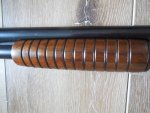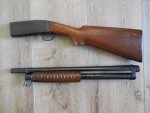John Pedersen design c.pre 1920. This gun was given to a federal bank in Cicero Ill, in the 1930's by the FBI. The stock is stamped west cook county Il. bankers federal. It is in excellent condition, I don't believe it was ever shot. ( It probably sat in a safe). $1875.00 OBO
Remington Model 10 "Riot Gun" History
Unlike other global firepowers, the United States was never shy about going to war with shotguns in tow. This proved the case (even against German protests who deemed it, ironically, inhumane) in World War 1 (1914-1918) where the Remington Model 10 series pump-action shotgun was fielded to help shore up weapon stocks for US troops heading to Europe. Some even saw service in the lead-up to World War 2 (1939-1945) and thereafter. Design of the Model 10 was attributed to gunsmith John Pedersen (1881-1951), a man regarded by John Moses Browning himself as the "Greatest Gun Designer in the World". Many of Remington's sport-shooting designs of the period could be traced back to Pedersen's involvement though his military-minded endeavors often fell short through no fault of his own. John Pedersen was the developer of the notable "Pedersen Device" - an assembly that was to be added to the M1903 Springfield service rifle allowing for firing of .30 caliber short cartridges through a semi-automatic action, essentially making the bolt-action M1903 a semi-automatic rifle in nature. Unfortunately, despite production lines beginning to output the assembly, the Pedersen Device was doomed by the cessation of hostilities in World War 1 - the Armistice being signed in November of 1918. The Model 10 shotgun was introduced to Remington lines in 1910, originally as a sporting system. Production would ultimately span from 1908 until 1929 before the type was discontinued. All versions were 12-gauge and barrel lengths offered were the long-form 32-inch model and a shortened, compact 20-inch version. The action was manual through working of the slide mounted under the barrel and around the cylindrical magazine. The magazine was of basic tube form and incorporated up to five shells inline. A button along the right side of the receiver was held down with each pump-action to introduce a fresh shell into the chamber and eject any spent ones. The loading port was located under the receiver ahead of the trigger and doubled as the ejection port. Take-down was relatively easy and produced two components - the barrel/magazine tube with slide and the receiver with shoulder stock and trigger group. Each model featured a fixed, ergonomic solid wood stock attached to the end of the receiver with a formed pistol grip. The slide was also wooden and usually ribbed for a firm grip. An iron sight was forged just aft of the muzzle. The proper position for Model 10 function was the firing hand around the grip, the shoulder stock tucked into the shoulder pit and the supporting hand at the pump-action slide. The weapon's rate-of-fire was, therefore, limited to the speed of the action while reloading was relatively simple.
When the United States committed to World War in 1917, the Remington concern was charged with delivering a militarized version of their Model 10 (Model 10-A) (other firearms manufactures were also brought into the mix). This produced a line of weapons recognized generically as "Trench Shotguns". More or less faithful to their sporting core, Model 10 Trench Shotguns were given shortened 23-inch barrels for compactness, a wooden heat shield fitted over the barrel to protect the forward hand, sling swivels for a shoulder strap and bayonet mountings under the muzzle to support the US military's standard M1917 bayonet. These versions were used in a frontline fashion alongside the competing Winchester Model 1897 shotguns, the Winchester proving the principle US Army shotgun of the war. To shore up requirements for guard duty, the Model 10 was also procured in a 20-inch barrel form (recognized as the "Riot Gun"). Like the Model 1897, the Remington Model 10 was also purchased in 26- and 30-inch barrel forms for training aircraft gunners in the fine art of shooting moving targets at range. Some 3,500 to 5,000 Remington Model 10s were produced for the US Army during World War 1. Shotguns certainly held value in close-quarters combat - whether they be used in house-to-house fighting or trench-clearing sorties. While the machine gun and service rifle dominated the long-ranged aspects of the war, it would be weapons such as shotguns, pistols, grenades and knives/bayonets that would be called to flush out or neutralized remaining enemy forces in defensive positions. The repeat-fire nature and inherent firepower of a shotgun proved priceless in the confines of trench warfare and the Model 10 did not disappoint in that respect (nor did any of the other competing shotgun marks for the US military during the conflict). Its lethality is what prompted German protests against the weapon in the latter stages of the war - of course the German Empire itself guilty of utilizing poison gas against Allied troops in the field. Over 275,500 Remington Model 10s were eventually produced. In its militarized form, the shotgun would last in official operational service into the 1930s, particularly with US Marine Corps elements who recognized a solid weapon when they saw one. The Model 10 line was dropped by Remington in 1929 and today remains something of a rare, prized collector's item. Model 10s were in limited circulation during the Korean War (1950-1953) and the Vietnam War (1955-1975). Remington's other shotgun design used in World War 1 was the Model 11 and this was a unrelated design based on a John Browning license with a notably different external appearance when compared to the Model 10.
Will ship, buyer pays shipping.
NV ID and bill of sale required.






Remington Model 10 "Riot Gun" History
Unlike other global firepowers, the United States was never shy about going to war with shotguns in tow. This proved the case (even against German protests who deemed it, ironically, inhumane) in World War 1 (1914-1918) where the Remington Model 10 series pump-action shotgun was fielded to help shore up weapon stocks for US troops heading to Europe. Some even saw service in the lead-up to World War 2 (1939-1945) and thereafter. Design of the Model 10 was attributed to gunsmith John Pedersen (1881-1951), a man regarded by John Moses Browning himself as the "Greatest Gun Designer in the World". Many of Remington's sport-shooting designs of the period could be traced back to Pedersen's involvement though his military-minded endeavors often fell short through no fault of his own. John Pedersen was the developer of the notable "Pedersen Device" - an assembly that was to be added to the M1903 Springfield service rifle allowing for firing of .30 caliber short cartridges through a semi-automatic action, essentially making the bolt-action M1903 a semi-automatic rifle in nature. Unfortunately, despite production lines beginning to output the assembly, the Pedersen Device was doomed by the cessation of hostilities in World War 1 - the Armistice being signed in November of 1918. The Model 10 shotgun was introduced to Remington lines in 1910, originally as a sporting system. Production would ultimately span from 1908 until 1929 before the type was discontinued. All versions were 12-gauge and barrel lengths offered were the long-form 32-inch model and a shortened, compact 20-inch version. The action was manual through working of the slide mounted under the barrel and around the cylindrical magazine. The magazine was of basic tube form and incorporated up to five shells inline. A button along the right side of the receiver was held down with each pump-action to introduce a fresh shell into the chamber and eject any spent ones. The loading port was located under the receiver ahead of the trigger and doubled as the ejection port. Take-down was relatively easy and produced two components - the barrel/magazine tube with slide and the receiver with shoulder stock and trigger group. Each model featured a fixed, ergonomic solid wood stock attached to the end of the receiver with a formed pistol grip. The slide was also wooden and usually ribbed for a firm grip. An iron sight was forged just aft of the muzzle. The proper position for Model 10 function was the firing hand around the grip, the shoulder stock tucked into the shoulder pit and the supporting hand at the pump-action slide. The weapon's rate-of-fire was, therefore, limited to the speed of the action while reloading was relatively simple.
When the United States committed to World War in 1917, the Remington concern was charged with delivering a militarized version of their Model 10 (Model 10-A) (other firearms manufactures were also brought into the mix). This produced a line of weapons recognized generically as "Trench Shotguns". More or less faithful to their sporting core, Model 10 Trench Shotguns were given shortened 23-inch barrels for compactness, a wooden heat shield fitted over the barrel to protect the forward hand, sling swivels for a shoulder strap and bayonet mountings under the muzzle to support the US military's standard M1917 bayonet. These versions were used in a frontline fashion alongside the competing Winchester Model 1897 shotguns, the Winchester proving the principle US Army shotgun of the war. To shore up requirements for guard duty, the Model 10 was also procured in a 20-inch barrel form (recognized as the "Riot Gun"). Like the Model 1897, the Remington Model 10 was also purchased in 26- and 30-inch barrel forms for training aircraft gunners in the fine art of shooting moving targets at range. Some 3,500 to 5,000 Remington Model 10s were produced for the US Army during World War 1. Shotguns certainly held value in close-quarters combat - whether they be used in house-to-house fighting or trench-clearing sorties. While the machine gun and service rifle dominated the long-ranged aspects of the war, it would be weapons such as shotguns, pistols, grenades and knives/bayonets that would be called to flush out or neutralized remaining enemy forces in defensive positions. The repeat-fire nature and inherent firepower of a shotgun proved priceless in the confines of trench warfare and the Model 10 did not disappoint in that respect (nor did any of the other competing shotgun marks for the US military during the conflict). Its lethality is what prompted German protests against the weapon in the latter stages of the war - of course the German Empire itself guilty of utilizing poison gas against Allied troops in the field. Over 275,500 Remington Model 10s were eventually produced. In its militarized form, the shotgun would last in official operational service into the 1930s, particularly with US Marine Corps elements who recognized a solid weapon when they saw one. The Model 10 line was dropped by Remington in 1929 and today remains something of a rare, prized collector's item. Model 10s were in limited circulation during the Korean War (1950-1953) and the Vietnam War (1955-1975). Remington's other shotgun design used in World War 1 was the Model 11 and this was a unrelated design based on a John Browning license with a notably different external appearance when compared to the Model 10.
Will ship, buyer pays shipping.
NV ID and bill of sale required.






Last edited:












